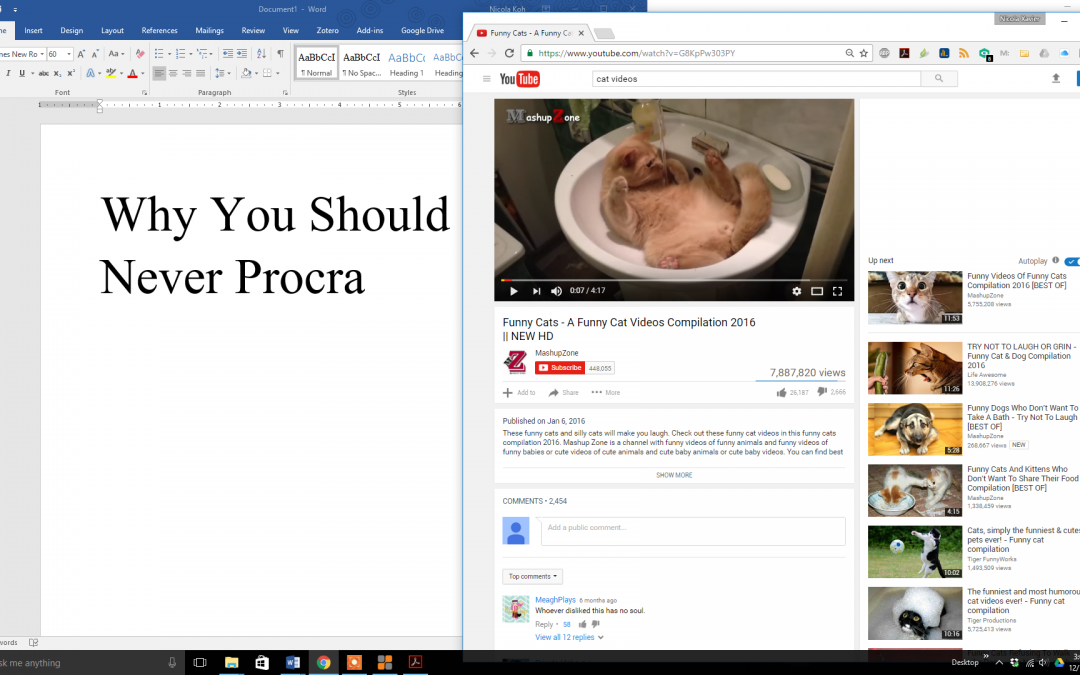A show of hands if you have procrastinated in the last month, the last week, TODAY. To some, procrastination is a familiar companion; to others, it is a dreaded drain on their time and productivity. So, if we know what it is, why do we continue to do it? The interesting thing about procrastination is it is often viewed as a lifestyle. In other words, if those who put things off until later, tomorrow, next week (or never) don’t notice any significant consequences, why should they change?
According to an article in Psychology Today twenty percent of people think of themselves as chronic procrastinators. This isn’t limited to college students, but to anyone who is habitually late—paying bills, filing income tax returns, getting in on the hot tickets for concerts and events, even Christmas shopping. In other words, it’s an issue of self-regulation, especially prevalent in the U.S.
Researchers say procrastination is a learned behavior and one which has a host of negative consequences: increased substance use, weakened immune system, even going so far as to jeopardize jobs, credit, and relationships. So, perhaps the unexplained cold and flu symptoms that arise as you cram at the end of the semester are, at least in part, the result of putting things off until the last minute.
Since many of you reading this undergraduate blog are students, let’s narrow our focus to help you navigate your thesis projects, cramming exams, or never-ending paper assignments. Here are some quick and practical suggestions:
Size Up the Assignment. Schedule thirty minutes where you assess what needs to be done, then divide the workload into manageable sections. A crucial aspect of this first step is being honest about how much time you have or will have available to accomplish your goals. Plan accordingly.
“Inch by Inch, Anything’s a Cinch.” Find a place to begin. Write an outline or the first paragraph. Once you have something on the page, moving forward will seem less daunting. Rome wasn’t built in a day so be realistic in your expectations.
Consistency is Key. Once you’ve begun, keep the momentum going by scheduling blocks of time (15-30 minutes per sitting) devoted to your project. I’ve also found that keeping a notebook handy to jot down ideas is a great way to maximize what would otherwise be “wasted time.”
Be About Actions, Not Distractions. Distractions are the bane of a student’s existence. Be your own best advocate by finding an out-of-the-way place to work for the scheduled amount of time. If you work well in a busy coffee shop, go there. But if you find yourself socializing with the barista or everyone who walks in the door, pick a new spot. If you really want to maximize your time, your cell phone and connection to Wi-Fi need to be turned OFF.
Never Underestimate the Carrot. Some projects are more difficult than others. I have always believed incentives go a long way in slogging through projects and I use rewards routinely (for instance, when I complete this blog I’m grabbing a bite to eat with friends). The key is choosing a reward which is meaningful to you, and of course completing the task first.
Study Partners. In theory, this is a good idea. But it only works well if your partner has similar goals and standards. Should I choose a chatty Kathy or someone who buckles down and gets the work done? Is my potential partner ok with “D is for Diploma” or are they aiming higher? It’s crucial to pick someone who is aiming for similar goals.
Perfectionism. You will be assigned hundreds, if not thousands, of assignments during your college career. Some you will execute well and others—due to lack of sleep, illness, or a good time the night before—not so much. There is no such thing as perfect and you’ll make yourself crazy holding your work to this impossible standard. Do your best and turn the work in. Period.
My hope is these suggestions prove helpful. In the meantime, enjoy this hilarious TED talk featuring master procrastinator, Tim Urban. Then, back to work.
Meet the blogger:
 DEBBIE JOHNSON-HILL is a poet, freelance writer, and photographer. Her work has appeared in The Atrium, Century Times, Fulcrum, Red Flag Poetry, andThe View from Here: Poetry to Help You Soar, as well as Maple Grove, Southwest Metro, St. Croix Valley, and White Bear Lake Magazines.
DEBBIE JOHNSON-HILL is a poet, freelance writer, and photographer. Her work has appeared in The Atrium, Century Times, Fulcrum, Red Flag Poetry, andThe View from Here: Poetry to Help You Soar, as well as Maple Grove, Southwest Metro, St. Croix Valley, and White Bear Lake Magazines.


